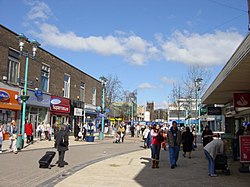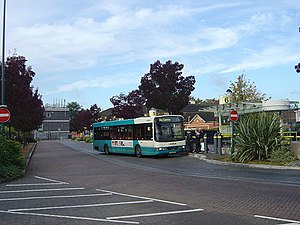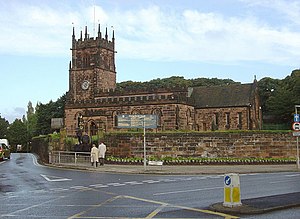Huyton
| Huyton | |
| Lancashire | |
|---|---|
 Huyton town centre | |
| Location | |
| Grid reference: | SJ4692 |
| Location: | 53°24’36"N, 2°50’35"W |
| Data | |
| Population: | 33,193 |
| Post town: | Liverpool |
| Postcode: | L14, L16, L36 |
| Dialling code: | 0151 |
| Local Government | |
| Council: | Knowsley |
| Parliamentary constituency: |
Knowsley |
Huyton is a town in southern Lancashire that forms part of the Liverpool Urban Area. It shares borders with the Liverpool suburbs of Dovecot, Knotty Ash, and Belle Vale. Huyton has close associations with the neighbouring village of Roby.
The ancient parish contains Croxteth Park, Knowsley and Tarbock, in addition to the township of Huyton-with-Roby. It forms part of the West Derby Hundred.
History
Mediæval
Huyton was first settled about AD 600–650 by Angles.[1] The settlement was founded on a low hill surrounded by inaccessible marshy land. The first part of the name may suggest a landing-place, probably on the banks of the River Alt.[2]
Both Huyton and Roby are mentioned in the Domesday Book of 1086, Huyton being spelt Hitune.
Industrial development
Huyton-with-Roby is situated near to the south western extremity of the Lancashire coalfield. In the 19th century migrants from northern Wales settled in the area to work in nearby colleries. A Welsh-speaking Non-conformist chapel (Calvinistic Methodists) was founded in Wood Lane, Huyton Quarry. Nearby Cronton Colliery finally ceased production in March 1984, shortly before the UK miners' strike (1984–1985). Both Huyton and Roby have stations on the Liverpool and Manchester Railway (another station, Huyton Quarry, closed in 1958). The railway's construction was supervised by George Stephenson and, when it opened in 1830, it became the world's first regular passenger train service. On the day of the railway's official opening, Arthur Wellesley, 1st Duke of Wellington alighted the train at Roby station.[3]
Since the First World War, Huyton-with-Roby has been transformed into a residential suburb of Liverpool, while agriculture, formerly the area's main occupation, has almost disappeared".[4] In 1932 Liverpool City Council purchased a large area of the Earl of Derby's Knowsley estate. Thereafter, throughout the 1930s, the city built four large housing estates in the north-west of Huyton-with-Roby. These Liverpool 'overspill' housing estates were Fincham, Huyton Farm, Longview and Woolfall Heath. Other smaller developments were commissioned by the urban district council or privately commissioned. By 1950 the population was over 55,000, the vast majority of whom had moved to the area from the city of Liverpool. After the Second World War, the district successfully fought off absorption into the Liverpool City boundaries
Second World War
During the Second World War, Huyton suffered bombing from the Luftwaffe. Some Huyton residents were killed or injured but the scale of destruction was much less than that experienced by Liverpool, Bootle and Birkenhead. Unlike Liverpool, schoolchildren were not evacuated from Huyton but schools and homes were provided with air-raid shelters.
Huyton was also host to three wartime camps: an internment camp, a prisoner-of-war camp and a base for American servicemen.
The internment camp, one of the biggest in the country, was created to accommodate those 'enemy aliens' deemed a potential threat to national security. Churchill's demand to 'collar the lot' meant that around 27,000 people ended up being interned in the UK. Some internees were actually refugees from the Nazis, including socialists such as Kurt Hager and a large number of artists attacked for their 'degeneracy' in an infamous Nazi art exhibition in 1937. Huyton internees included artists Martin Bloch, Hugo Dachinger, and Walter Nessler, dancer Kurt Jooss, musicians, sociologist Norbert Elias, anthropologist Eric Wolf and composer Hans Gál.[5] More than 40 per cent of Huyton's internees were over 50 years old.
The camp, first occupied in May 1940, was formed around several streets of new, empty council houses and flats and then made secure with high barbed-wire fencing. Twelve internees were allocated to each house, but overcrowding resulted in many sleeping in tents. Initially the camp was only meant to hold the internees until they could be shipped to the Isle of Man. However, largely in response to the torpedoing of the transport ship The Arandora Star, with the loss of nearly 700 lives, the deportations ended. Most of the internees were released long before the camp closed in 1942. The camp was sited in and around what became known as the 'Bluebell Estate' and many of the streets were given names of the great battles of the Second World War.
The prisoner of war camp closed in 1948. Many of its inmates 'went native', stayed in Britain and married local women. Among those in the Huyton camp was Bert Trautmann who later went on to be the 1950s goalkeeper for Manchester City. From 1944, American servicemen were temporarily stationed in Huyton. Older Huyton residents still recall the tensions between black and white GIs which resulted in a night known as ‘the shoot out at the Eagle and Child’ (a local public house).[6]
Transport
Huyton is located just west of the M57 motorway which marks its border. Liverpool city centre is six miles to the west via the M62 motorway. Huyton railway station, formerly called Huyton Gate, is served by regular City Line services to and from Liverpool, St Helens, Wigan and further afield.
Huyton Bus Station

Huyton Bus Station is on Huyton Hey Road, adjacent to the shopping centre and 140 yardsaway from the Huyton railway station.[7]
Buses from Huyton bus station serve destinations such as Liverpool, Kirkby, St Helens, Warrington, Runcorn and Liverpool John Lennon Airport.
Education
Huyton has one secondary school – Lord Derby Academy on Seel Road – and 15 primary schools. It also has a sixth form on Rupert Road, called the Roby Campus (part of Knowsley Community College). A construction training college is on Princess Drive.
Amenities

The shopping centre of Huyton is still referred to by local people as "the village" or "the villie", which dates back to the days when the centre was a rural village community. An Asda Walmart complex has been built nearby. There are also around 100 other independent shops and an indoor market.
The area has two libraries: Huyton Library (Civic Way) and Page Moss Library (Stockbridge Lane). There is also a contemporary art gallery at Huyton Library.
There are eight public parks: Court Hey Park, Bowring Park (the oldest public park in Knowsley, opened in 1907), Huyton Lane Wetland, Jubilee Park (Twig Lane/Dinas Lane), McGoldrick Park (Rydal Road), Sawpit Park (Hall Lane/Sawpit Lane), Stadt Moers Park (covers more than 220 acres of land between Whiston and Huyton) and St John's Millennium Green (Manor Farm Road). There are also nine children's playgrounds.
Huyton has a King George's Field in memorial to King George V. It also has one of the biggest dogs' homes in Merseyside, Dogs' Trust, located on Whiston Lane.
Huyton has many public houses including The Huyton Park Hotel, The Stanley Arms (named after Frederick Stanley, 16th Earl of Derby), The Crofters, Seel Arms, Queens Arms, Oak Tree, The Old Bank, Longview Social Club and The Swan. The former Wheatsheaf/Rose And Crown reopened as The Barker's Brewery on 23 January 2011, as part of the Wetherspoon chain of pubs. Several former landmark pubs have been demolished for new projects since the late 1990s: The Dovecot, Bluebell Inn, Farmers Arms, Hillside, Eagle and Child, The Quarry Inn and The Quiet Man.
Sport
The area is served by Knowsley Leisure and Culture Park (Longview Drive) and King George V Sports Centre (Longview Lane).
Huyton-with-Roby boasts two 18-hole golf courses: Huyton & Prescot Golf Club (founded in 1905) and Bowring Golf Club (according to a sign at the course, the oldest municipal golf course in England).
Huyton has its own cricket club, located off Huyton Lane which was founded in the mid-1860s by the Stone family and the town has produced at least one first class cricketer: Reginald Moss.
Huyton also had a professional rugby league club from 1968 to 1985. It was formed from Liverpool Stanley (1934–1951) and Liverpool City (1951–1968). Huyton RLFC struggled in the second division of the Rugby Football League until 1985, when they were replaced by Runcorn Highfield. This club, later renamed Highfield, struggled on near the bottom of the pro game: in 1995–1996 they gained just one point all season and changed their name to Prescot Panthers, before folding at the end of the 1997 season. (Huytonians still interested in supporting pro rugby league have the choice of either St Helens or Widnes Vikings, both of which are six miles away from Huyton).
In football, the town has produced two outstanding midfield England internationals: Peter Reid (Everton) and Steven Gerrard (Liverpool). Other footballers include Joey Barton, Craig Hignett, Tony Hibbert, David Nugent, Lee Molyneux, Leon Osman, John Relish, Greg Tansey, Lee Trundle and Callum McManaman. Notably on 28 March 2007, two of Huyton's most prominent footballers starred for England in a 3-nil away win in Andorra. Goals came from Steven Gerrard (2) and David Nugent in a proud night for Huyton. Both players were educated at Cardinal Heenan High School, who have a track record as one of the country's top schools for sport.
Huyton has many amateur football teams at both junior and senior level, but only one FA Charter Standard Club, Paramount Community Football Club.
Despite producing so many pro footballers, Huyton has never been able to sustain a semi-pro club for long. Nearby Kirkby Town changed their name to Knowsley United in 1988 and moved to Alt Park, the former home of Huyton Rugby League Club. In United's first five seasons they were successful. In 1988–89 they finished runners-up in the North West Counties Football League. The following season they were champions and won promotion to the Northern Premier League Division One. They were accordingly promoted to the Premier Division. The following season they reached the first round proper of the FA Cup, only to be beaten by Carlisle United at home. The momentum did not last and Knowsley United ceased to be a senior semi-pro side in 1998.
Huytonians wishing to support a local semi-pro outfit have Prescot Cables F.C. located at Valerie Park less than two miles away.
Notable people
Huyton-with-Roby has several Beatles connections. As The Quarrymen, the Fab Four played the MPTE Social Club in Finch Lane.[8] The Beatles also played 15 times in a hall in Page Moss (Hambleton Hall, St David Road; later became a Probation Office) between January 1961 and January 1962.[9] On 21 March 1961, The Swinging Blue Jeans, fronted by Huyton-born Ray Ennis (born Raymond Vincent Ennis on 26 May 1942), introduced the Beatles to their first ever Cavern Club evening slot.[10] Paul McCartney's auntie Jin lived in Dinas Lane. In 1963, this was the site of Paul's eventful 21st birthday party, at which John Lennon got drunk and beat up a local DJ for intimating he was a homosexual.[11] Huyton Parish Church churchyard is the final resting place of the Beatles’ original bass guitarist, Huytonian Stuart Sutcliffe.[12]
Notable music
- Black – 7 UK Top 70 singles between 1986 and 1991 including 'Wonderful Life' (No.8).[13]
- The Crescent – 3 UK Top 70 singles between May 2002 and Sept. 2002 including 'On The Run' (No.49).[14]
- The La's – 4 UK Top 70 singles between 1990 and 1997 including 'There She Goes' (No.13).[15]
- Space – 8 UK Top 30 hit singles between 1996 and 1998 including 'Avenging Angels' (No.6).[16]
Huyton does not have its own hospital, therefore most of its famous sons and daughters will have been born elsewhere, usually in Liverpool or Whiston. As well as the aforementioned footballers, the following people have or have had links with Huyton:
List of notable people
- Lee Mavers, frontman of the Brit-pop group The La's
- Matthew Murphy, guitarist / lead vocals of The Wombats
- Although born in St Helens, Thomas Beecham (1879–1961), the classical music conductor, was brought up in the Blacklow Brow area of Huyton. In 1947 he founded the Royal Philharmonic Orchestra.
- Alan Bleasdale, playwright known for Boys from the Blackstuff, attended St Aloysius RC Infant and Junior Schools, Huyton, 1951–1957.
- Stan Boardman, comedian.
- Henry Brunner, chemist. Resident in Huyton until his death.
- Carol Decker, rock singer.
- Alicya Eyo, actress.
- Sir Rex Harrison, actor who starred in films such as My Fair Lady and Cleopatra, was born and brought up on Tarbock Road in Huyton, and attended St Gabriel's School.
- Paul Lewis, pianist
- John McCabe, composer.
- Sally Morgan, Baroness Morgan of Huyton, politician.
- Reginald Moss, cricketer.
- Although originally from Manchester, Peter Noone (born 1947), of 1960s group Herman’s Hermits, settled in Chestnut Avenue, Huyton, before wealth and fame came knocking.
- Wes Paul, guitarist and singer. Although originally from Toxteth, lived in Huyton for 35 years.
- Barbara Pym novelist who was privately educated at Huyton College.
- Phil Redmond, the creator of TV shows Hollyoaks, Grange Hill and Brookside.
- Tony Schumacher, author and broadcaster.
- Freddie Starr, comedian.
- Stuart Sutcliffe, the fifth Beatle.
- Harold Wilson, former Labour Prime Minister (1964–70 & 1974–76) was Member of Parliament for Huyton constituency 1950–83.[17] A statue of Wilson was erected in Huyton town centre in 2006, 11 years after his death.
TV and radio
Boys from the Blackstuff episode "Jobs for the Boys" was partly filmed in Woodlands Road, Roby.
References
- ↑ King, Alan (1984). 'Huyton & Roby: A History of Two Townships'. Knowsley: Metro. Borough of Knowsley. p. 3. ISBN 0-947739-01-7.
- ↑ King, Alan (1984). 'Huyton & Roby: A History of Two Townships'. Knowsley: Metro. Borough of Knowsley. p. 5. ISBN 0-947739-01-7.
- ↑ King, Alan (1984). 'Huyton & Roby: A History of Two Townships'. Knowsley: Metro. Borough of Knowsley. p. 45. ISBN 0-947739-01-7.
- ↑ King, Alan (1984). 'Huyton & Roby: A History of Two Townships'. Knowsley: Metro. Borough of Knowsley. p. 55. ISBN 0-947739-01-7.
- ↑ "Hans Gál's Internment in Huyton". Anthony Fox & Eva Fox-Gál. http://www.hansgal.com/biography/19-internment.html. Retrieved 1 February 2008.
- ↑ "Wartime camps in Huyton". BBC Liverpool. http://www.bbc.co.uk/liverpool/content/articles/2006/04/24/huyton_internment_camp_feature.shtml. Retrieved 1 February 2008.
- ↑ [1] Template:Webarchive
- ↑ Harry, Bill (2000) The Beatles Encyclodedia, Virgin Publishing, London, p.782;
- ↑ Harry, Bill (2000) The Beatles Encyclodedia, Virgin Publishing, London, p.474;
- ↑ Harry, Bill (2000) The Beatles Encyclodedia, Virgin Publishing, London, p.1055;
- ↑ Harry, Bill (2000) The Beatles Encyclodedia, Virgin Publishing, London, p.340;
- ↑ Harry, Bill (2000) The Beatles Encyclodedia, Virgin Publishing, London, p.536;
- ↑ Strong, M.C. (2003) The Great Indie Discography, Canongate, Edinburgh, p. 229;
- ↑ Strong, M.C. (2003) The Great Indie Discography, Canongate, Edinburgh, p.692;
- ↑ Strong, M.C. (2003) The Great Indie Discography, Canongate, Edinburgh, p.393;
- ↑ Strong, M.C. (2003) The Great Indie Discography, Canongate, Edinburgh, p.989;
- ↑ Mark Clapson (2009-06-23). "The Routledge Companion to Britain in the Twentieth Century". Books.google.co.uk. p. 283. https://books.google.co.uk/books?id=HwyCAgAAQBAJ&pg=PA283&lpg=PA283&dq=wilson+mp+for+ormskirk&source=bl&ots=2QEHEe0x91&sig=0P4KA5XJVaFzHA3afsukdT6aAQQ&hl=en&sa=X&ei=RrjPVKCbIsGI7Abp2oHIDw&ved=0CEMQ6AEwCA#v=onepage&q=wilson%20mp%20for%20ormskirk&f=false. Retrieved 2015-11-09.
Outside links
| ("Wikimedia Commons" has material about Huyton) |
- Huyton Parish Church, Huyton
- Liverpool Street Gallery – Liverpool 36
- Knowsley local history website – Detailed summary of the history of Huyton.
- The Huyton Times – Contains a message board and photos comparing old and new Huyton sites.
- McGoldrick Park
- Paramount Community Football Club
